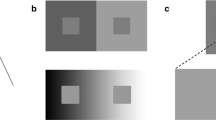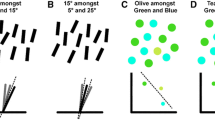Abstract
In a series of three separate experiments, we studied two different orientation illusions, in both of which vertical lines appear tilted as a result of being set against a tilted background pattern. The ‘simultaneous tilt illusion’ (STI), in which a target grating is viewed within an abutting tilted grating surround, is thought to originate early in the cortical processing of visual contours. In contrast, the ‘rod-and-frame’ illusion (RFI), which is induced by a distant tilted frame, is thought to originate much later in the perceptual processing system. In the first two experiments we found that orientationguided action was virtually impervious to the RFI, whereas both perceptual experience and action were equally influenced by the STI. In the third experiment, in which the two illusions were pitted one against the other, an opposite pattern of effects emerged, such that visuomotor performance was now deceived by the illusion much more than was perceptual experience. This pattern of association and dissociation in the effects of visual illusions on perception versus action can best be explained within a two-visual-systems model of cortical processing.
Similar content being viewed by others
Author information
Authors and Affiliations
Corresponding author
Rights and permissions
About this article
Cite this article
Dyde, R.T., Milner, A.D. Two illusions of perceived orientation: one fools all of the people some of the time; the other fools all of the people all of the time. Exp Brain Res 144, 518–527 (2002). https://doi.org/10.1007/s00221-002-1065-1
Received:
Accepted:
Published:
Issue Date:
DOI: https://doi.org/10.1007/s00221-002-1065-1




